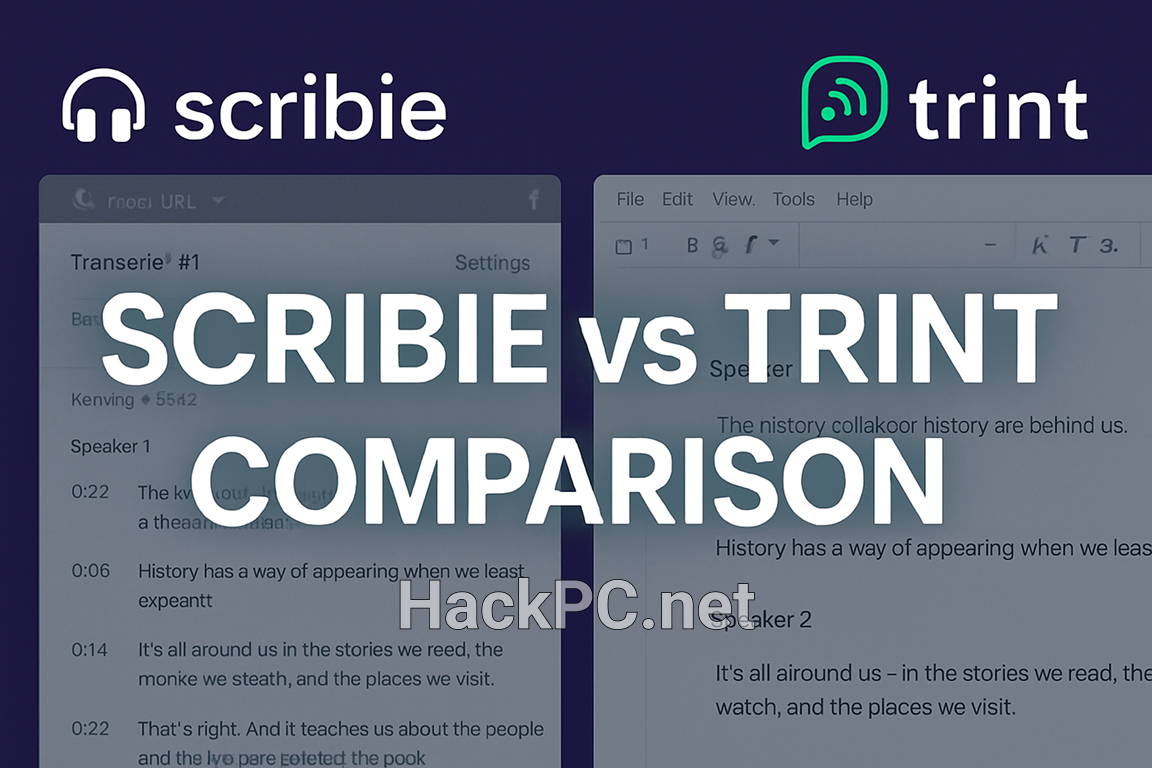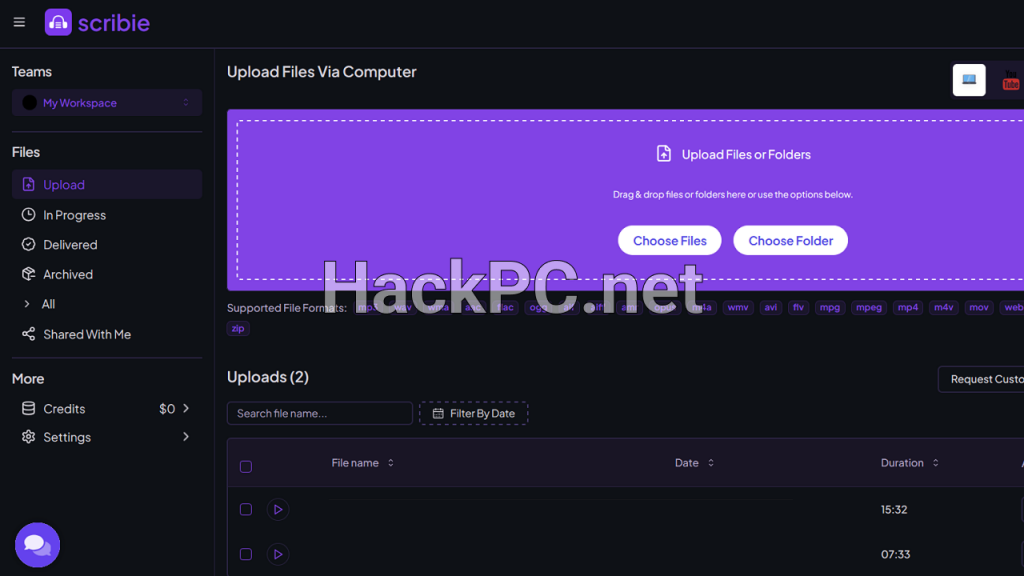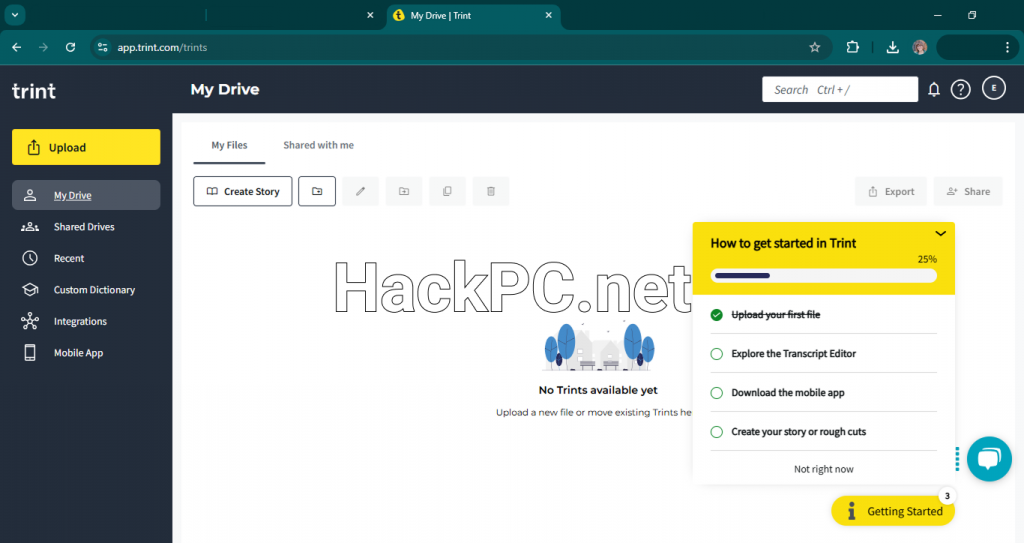
When the transcription industry underwent its AI revolution, two platforms emerged with fundamentally different philosophies about converting speech to text. Having extensively tested both Scribie and Trint throughout 2025, I’m here to dissect what makes these transcription powerhouses tick—and which one deserves your investment.
The Transcription Landscape Revolution
The modern transcription ecosystem isn’t just about converting audio files anymore—it’s about intelligent content transformation, real-time collaboration workflows, and creating searchable knowledge repositories. Traditional manual transcription services that once dominated the market now compete with sophisticated AI-powered platforms offering near-instantaneous results across multiple languages.
Background Context
Scribie has steadfastly maintained its commitment to human-verified accuracy since 2008, building a network of over 50,000 certified transcribers who follow a meticulous four-step quality assurance process. Meanwhile, Trint, founded by Emmy Award-winning journalist Jeff Kofman in 2014, represents the cutting edge of automated speech recognition technology, particularly tailored for media professionals and content creators.
Core Comparative Framework
Transcription Accuracy & Methodology
Scribie’s Human-Powered Precision
The platform’s four-step transcription workflow involves raw transcription, comprehensive review, detailed proofreading, and final quality assessment. This multi-layered approach consistently delivers 99%+ accuracy rates, particularly excelling with challenging audio containing technical jargon, multiple speakers, or non-native English accents. Recent testing revealed that clear audio files processed through Scribie’s system achieved near-perfect accuracy, with human transcribers catching nuances that automated systems typically miss.
Trint’s AI-Driven Speed
Leveraging advanced machine learning algorithms and natural language processing, Trint delivers automated transcripts with up to 95-99% accuracy for high-quality recordings. The platform processes files approximately in real-time—a 30-minute audio file typically completes transcription within 30 minutes. While impressive for clear recordings, accuracy diminishes with background noise, crosstalk, or heavily accented speech.

Pricing Architecture & Value Proposition
Scribie’s Pay-As-You-Go Model
Starting at $0.80 per audio minute for standard turnaround, Scribie’s transparent pricing structure scales based on urgency and audio quality. Express delivery (8-12 hours) costs extra, while rush orders (3 hours) can reach $2.00 per minute. Volume discounts make large projects more economical, though costs accumulate quickly for regular users processing substantial content volumes.
Trint’s Subscription Economics
The platform operates on monthly subscription tiers: Starter ($52/month annually) allows seven files monthly, while Advanced ($80/month) offers unlimited transcription. Enterprise plans include API access, enhanced security features, and dedicated customer success management. For high-volume users, Trint’s unlimited plans provide exceptional value, though casual users might find the subscription model restrictive.
Feature-Rich Functionality Analysis
Editorial & Collaboration Tools
Scribie’s Streamlined Approach
The browser-based editor provides essential editing capabilities, timestamp synchronization, and speaker tracking. While functional, the interface lacks modern polish—fonts appear dated, and the editing window opens separately, disrupting workflow continuity. Export options include standard formats (DOC, TXT, SRT/VTT), with additional formatting available as paid add-ons.
Trint’s Media Professional Suite
The platform shines with its Story Builder feature, enabling journalists and content creators to extract key quotes, create article drafts, and build podcast outlines directly from transcripts. Real-time collaboration allows teams to simultaneously edit documents, leave contextual comments, and manage version control. The interface mirrors familiar tools like Google Docs, reducing learning curves for new users.
Language Support & Global Accessibility
Scribie’s English Focus
Currently limited to English transcription, Scribie excels at handling various English accents—American, British, Australian, Indian, and African. This specialization ensures exceptional accuracy for English content but limits international applicability.
Trint’s Multilingual Mastery
Supporting transcription in over 40 languages and translation into 50+ languages, Trint serves global audiences effectively. Live transcription capabilities capture events in real-time across 30+ languages, making it invaluable for international conferences, multilingual interviews, and cross-border content creation.
Performance Benchmarks & Real-World Testing
Turnaround Speed Comparison
Recent independent testing revealed fascinating performance disparities. A complex one-hour interview with multiple speakers and technical terminology:
- Scribie: Delivered in 32 minutes for a 1:17 audio file (human transcription), maintaining 99% accuracy
- Trint: Completed in approximately real-time (60 minutes for 60-minute file), achieving 92% accuracy with required manual corrections
Audio Quality Resilience
Testing with deliberately challenging audio—background music, overlapping conversations, phone recordings—exposed each platform’s limitations:
- Scribie: Human transcribers successfully disambiguated speaker overlap, correctly identified industry-specific terminology, and maintained consistency despite audio degradation
- Trint: AI struggled with speaker differentiation in noisy environments, occasionally misinterpreted technical terms, but excelled with clear, single-speaker recordings
Security & Compliance Infrastructure
Data Protection Protocols
Scribie’s Confidentiality Framework
All transcribers operate under strict non-disclosure agreements, with file access restricted on need-to-know basis. The platform complies with standard industry security practices but lacks advanced certifications.
Trint’s Enterprise-Grade Security
ISO 27001 certified with dedicated US and EU data servers, Trint meets stringent compliance requirements for legal, medical, and government sectors. The platform explicitly states it never uses customer content for AI training, ensuring complete data privacy.
Integration Ecosystem & Workflow Automation
Platform Connectivity
Scribie’s Basic Integration
Limited third-party integrations focus on essential file management—Dropbox and Google Drive support enables basic workflow automation. The absence of API access restricts enterprise-level implementation.
Trint’s Comprehensive Connectivity
Zapier integration unlocks connections with 1000+ applications, while native API support enables custom workflow development. Direct integration with content management systems streamlines publication pipelines for media organizations.
User Experience & Learning Curve
Interface Design Philosophy
Scribie’s Functional Minimalism
The platform prioritizes functionality over aesthetics, resulting in a utilitarian interface that accomplishes tasks without flourish. New users navigate basic functions easily, though advanced features require documentation consultation.
Trint’s Intuitive Modernism
Contemporary design principles create an immediately familiar environment for users accustomed to modern productivity tools. Contextual tooltips, guided onboarding, and comprehensive video tutorials minimize training requirements.

Customer Support & Community Resources
Support Infrastructure Comparison
Scribie’s Responsive Assistance
Email support and live chat (weekdays) provide adequate assistance for routine inquiries. The knowledge base covers common scenarios, though complex technical issues may require escalation.
Trint’s Multi-Channel Support
Comprehensive support includes email, live chat, extensive documentation, and video tutorials. Enterprise customers receive dedicated success managers and personalized onboarding sessions. The absence of phone support might frustrate users requiring immediate assistance.
Market Positioning & Ideal Use Cases
When to Choose Scribie
Professional transcriptionists, academic researchers, and legal professionals requiring absolute accuracy should prioritize Scribie. The human-verified approach ensures nuanced understanding of context, technical terminology, and speaker intent—critical for depositions, medical records, or scholarly interviews. Budget-conscious users processing occasional files benefit from pay-per-minute pricing without subscription commitments.
When to Select Trint
Media organizations, content marketing teams, and international businesses requiring rapid turnaround and multilingual support find Trint invaluable. The platform’s editorial tools, real-time collaboration features, and translation capabilities create comprehensive content production workflows. High-volume users maximize value through unlimited subscription plans, while API access enables enterprise-scale automation.
Performance Metrics & ROI Analysis
Cost-Efficiency Calculations
For typical usage scenarios:
- 100 hours monthly transcription:
- Scribie: $4,800 (at $0.80/minute base rate)
- Trint: $80 (Advanced plan with unlimited transcription)
- Occasional use (5 hours monthly):
- Scribie: $240
- Trint: $52-80 (depending on plan)
The breakeven point favors Trint for regular users processing over 1.5 hours monthly, while Scribie provides better value for sporadic, high-accuracy requirements.
Future-Proofing & Industry Trends
Technological Evolution Trajectory
Scribie’s recent migration to scribie.ai signals potential AI integration while maintaining human verification superiority. The platform’s temporary pause in hiring transcribers suggests significant infrastructure changes ahead.
Trint’s continuous AI refinement, expanding language support, and deepening enterprise features position it well for evolving market demands. Recent partnerships with major media organizations validate its strategic direction.
The Verdict: Context-Dependent Excellence
Neither platform claims universal superiority—each excels within specific parameters. Scribie delivers unmatched human-verified accuracy for English content, perfect for scenarios where precision trumps speed. Trint revolutionizes high-volume, multilingual transcription workflows with AI-powered efficiency and collaborative tools.
Decision Framework
Choose Scribie when:
- Accuracy requirements exceed 99%
- Processing English-only content
- Handling sensitive legal/medical transcriptions
- Working with challenging audio quality
- Preferring pay-per-use pricing
Select Trint when:
- Requiring rapid turnaround times
- Managing multilingual content
- Needing extensive collaboration features
- Processing high monthly volumes
- Integrating with existing workflows
Market Alternatives Worth Considering
The transcription landscape extends beyond this comparison. Rev offers hybrid AI/human options with competitive pricing. Otter.ai specializes in meeting transcription with impressive real-time capabilities. Sonix provides comprehensive AI features at lower price points than Trint.
Final Recommendations
For legal firms, academic institutions, and precision-critical applications, Scribie’s human-verified accuracy justifies its higher per-minute costs. Media professionals, content creators, and international organizations benefit more from Trint’s speed, collaboration tools, and multilingual capabilities despite occasional accuracy trade-offs.
The transcription industry’s future lies in hybrid approaches—combining AI efficiency with human expertise. Until that convergence fully materializes, choosing between Scribie and Trint requires carefully evaluating your specific accuracy requirements, turnaround expectations, volume needs, and workflow integration priorities.
Smart transcription strategy in 2025 might even involve using both platforms strategically: Trint for rapid first drafts and content organization, Scribie for critical sections requiring absolute precision. This dual-platform approach maximizes each service’s strengths while mitigating individual limitations.
Remember: The best transcription service isn’t necessarily the most advanced or affordable—it’s the one that seamlessly integrates into your workflow while meeting your accuracy and efficiency requirements.



Comments (0)